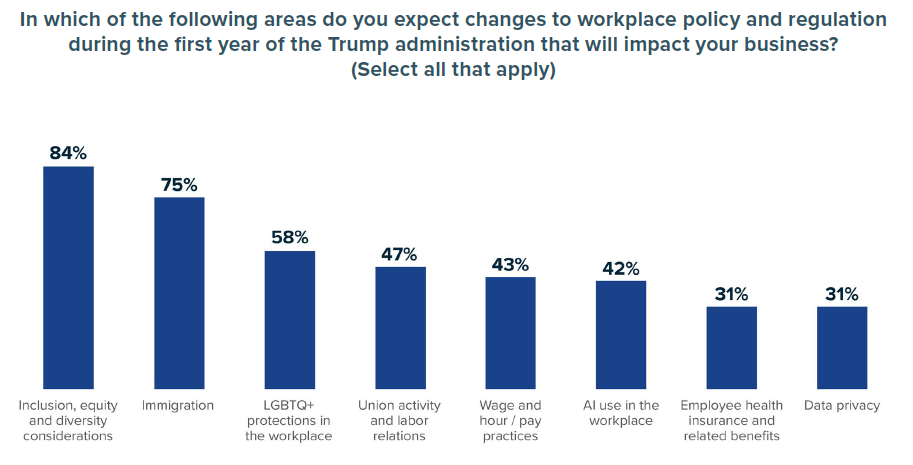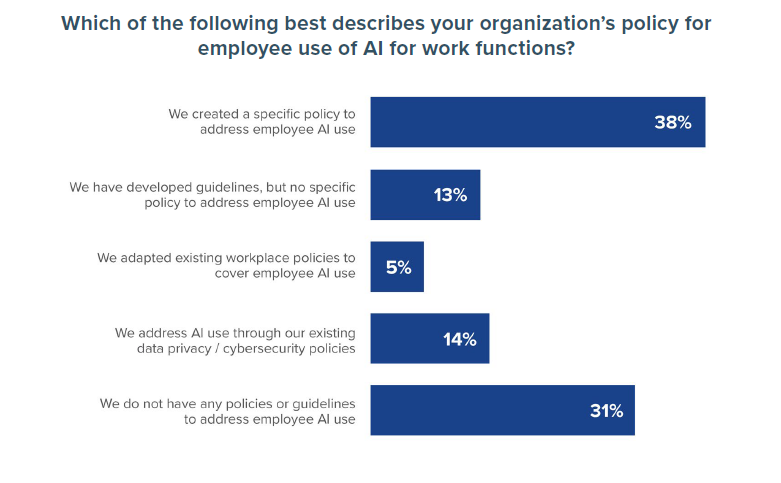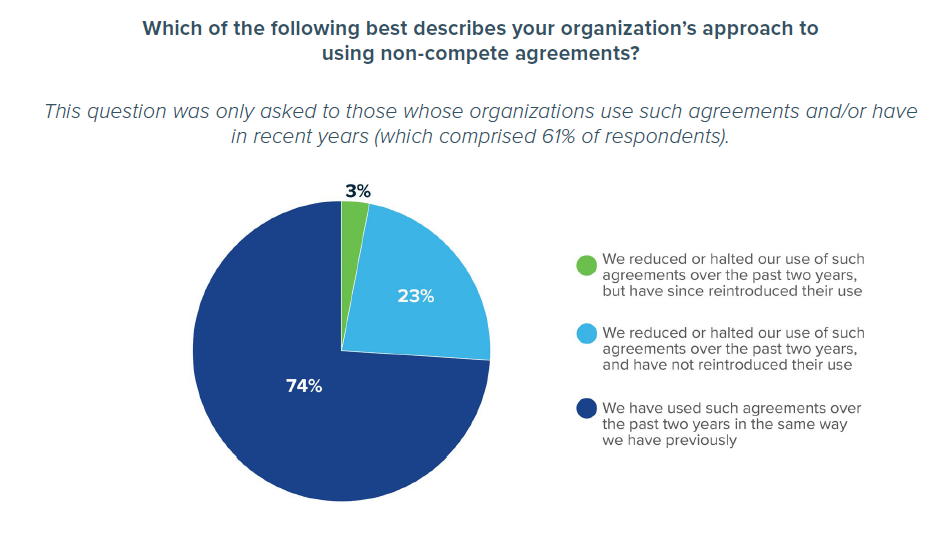Each year, Littler’s Annual Employer Survey captures key trends for HR, Compliance, and Legal teams and how they are responding to a rapidly changing regulatory landscape. As a Littler company, ComplianceHR brings these insights into sharper focus—helping you create a proactive HR compliance strategy with real-time updates and practical guidance.
To glean deeper insights into how businesses are adjusting their HR compliance and employment law efforts to better align with industry trends, Littler surveyed nearly 350 in-house lawyers, business executives, and human resources professionals across a range of company sizes and industries, like technology, manufacturing, retail, healthcare, and hospitality.
This year’s report reflects growing tension between federal and state policy shifts, increased litigation risk, and an accelerating pace of tech adoption—all of which demand close attention from HR and legal teams. Below, we highlight six key trends for HR, Compliance, and Legal teams from the 2025 survey and offer actionable takeaways for employers.
DEI Programs Face Legal and Political Headwinds
With both the Trump administration launching a campaign aimed at dismantling diversity, equity, and inclusion policies across the federal government and private sector during its first 100 days, the majority of respondents are anticipating DEI-related business disruptions in 2025.
According to Littler, “Just days into his second term, Trump signed executive orders to end IE&D programs in the federal government, reverse long-standing affirmative action requirements for federal contractors, and instruct federal agencies to identify private sector targets for IE&D investigations.”
- 84% of employers expect new regulations around inclusion, equity, and diversity (IE&D, or DEI) will impact their organizations
- 45% are concerned about DEI-related litigation, nearly double last year’s figure
- Despite this, almost half of respondents are maintaining or expanding DEI initiatives

What it means: Companies should assess diversity, equity, and inclusion policies for legal risk while continuing to meet cultural and workforce expectations.
How to prepare: In addition to helping you create a compliant employee handbook, PolicySmart™ also provides a timeline of HR compliance and employment law updates to help you track federal, state, and jurisdictional policy changes. If you’re not a ComplianceHR client, you can view national and jurisdictional legal updates on the Compliance Updates page of our website.
Immigration Compliance Creates Operational Risk
Employers are anticipating increases in audits and raids from Immigration and Customs Enforcement (ICE) and immigration-related workplace policy and regulatory shifts in 2025. In the Annual Survey Report, Littler shares, “Employers have reasonable cause for worry—it is anticipated, after all, that Trump 2.0 will increase ICE/HSI I-9 audits to up to 15,000 a year and ICE raids to more than 100 a year—workplace enforcement actions as of the writing of this report have not yet resulted in any formal ICE raids of employer worksites.”
- 75% of employers expect immigration policies and regulation changes to impact their businesses
- 58% are concerned about immigration-related staffing challenges resulting from the Trump administration’s immigration policies
- 70% expect moderate to significant disruption from federal enforcement activity

What it means: Organizations should anticipate the possibility of I-9 audits, visa processing delays, and both retention challenges and added costs for foreign workers.
How to prepare: ComplianceHR has national and state employee policy checklists in the PolicySmart solution. Ensure your company is implementing any required immigration policies and regularly review and update I-9 procedures.
Return-to-Office (RTO) Trends Increase Accommodation Requests
The next key trend for HR, Compliance, and Legal teams is Return-to-office accommodations. More than five years ago, the COVID-19 pandemic forced employers to change their workplace norms to accommodate employees working remotely. Today, many employers are implementing return-to-work policies and increasing in-person work requirements.
- Nearly 50% of companies are expanding in-office mandates
- 56% report a rise in accommodation requests tied to RTO
- 44% cite morale challenges
- 35% report increased turnover

What it means: Employers must strike a balance between business goals and accommodation obligations. With the increase in accommodation requests, 61% of large employers express concern about workplace accommodation lawsuits over the next year.
How to prepare: Stay informed on workplace accommodation laws and documentation requirements. The Policy News function of PolicySmart conveniently calls out which policy updates are required in addition to providing you with an ongoing timeline of employment law changes and updates as they are announced. For example, below you can see that Washington has enacted a required accommodation this month.

AI Use in Hiring and Monitoring on the Rise
While some employers have created specific policies to address employee AI use, the majority have not. Niloy Ray, Littler Shareholder and a member of the firm’s AI and Technology Practice Group, says, “It’s important, then, that AI governance be the provenance of not just IT but several other functions of an organization, including leaders who understand IP, privacy, the procurement cycle, and the broader legal and employee-side risks.”
- 31% of companies are increasing AI use in HR, reversing last year’s caution
- 44% are concerned about navigating state-specific AI hiring laws
- 25% are exploring AI monitoring tools, though many lack clear internal policies

What it means: With or without specific policies governing employee AI use, AI could pose a multitude of additional risks from employers.
How to prepare: Develop internal governance for AI use and continue to monitor jurisdiction-specific policies related to AI practices in hiring and workplace surveillance.
Religious Accommodation Rules Are Evolving
In recent years, religious expression concerns have entered the workplace in unprecedented ways, such as religious exemption requests regarding COVID-19 vaccination mandates, challenges to LGBTQ+ inclusion efforts, and even Islamophobia and antisemitism claims as a result of global conflicts.
- 45% reported religious accommodation requests last year
- 35% noted tensions between religious rights and IE&D efforts
What it means: According to Littler, “More workplace conflict may be on the horizon as the new administration, particularly the EEOC, prioritizes claims implicating religious protections.” How to prepare: Review your accommodation processes, especially following the Groff v. DeJoy decision, which raised the bar for denying requests.
Non-Compete Agreements Are Not a One-Size-Fits-All Solution
- 74% of employers have not changed non-compete usage, despite regulatory uncertainty
- 63% of those who did change their non-compete usage have opted not to reintroduce them
- 58% attribute their abandonment of non-competes to concerns about ongoing compliance burdens

What it means: Employers that took a “wait and see” approach before modifying their use of non-compete agreements may have had the right idea last year. The FTC’s proposed ban on non-competes is highly unlikely to ever take effect, Littler states in the Report.
How to prepare: Employers may want to re-evaluate their strategy with non-competes, especially if they made changes based on the FTC’s proposed ban in 2024. However, it’s critical to monitor state-specific policies regarding non-competes, as several states introduced legislation to restrict their use.
Staying Compliant in a Shifting Landscape
The key trends for HR, Compliance, and Legal teams in 2025 range from paid sick leave laws to wage history restrictions and AI policy gaps. This year’s employment law landscape demands proactive compliance strategies! The ComplianceHR Reference Center provides always-current guidance across all 50 states and jurisdictions—backed by Littler’s legal expertise.
Explore the tools that help you stay ahead of employment law trends and avoid costly compliance missteps.

